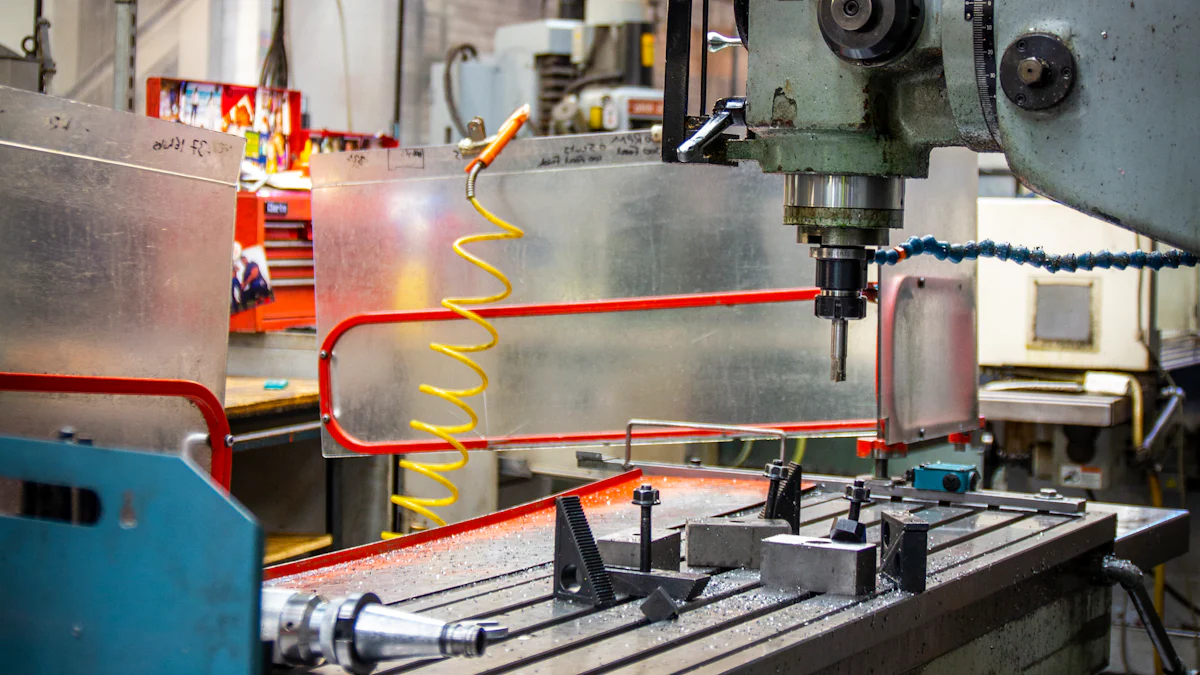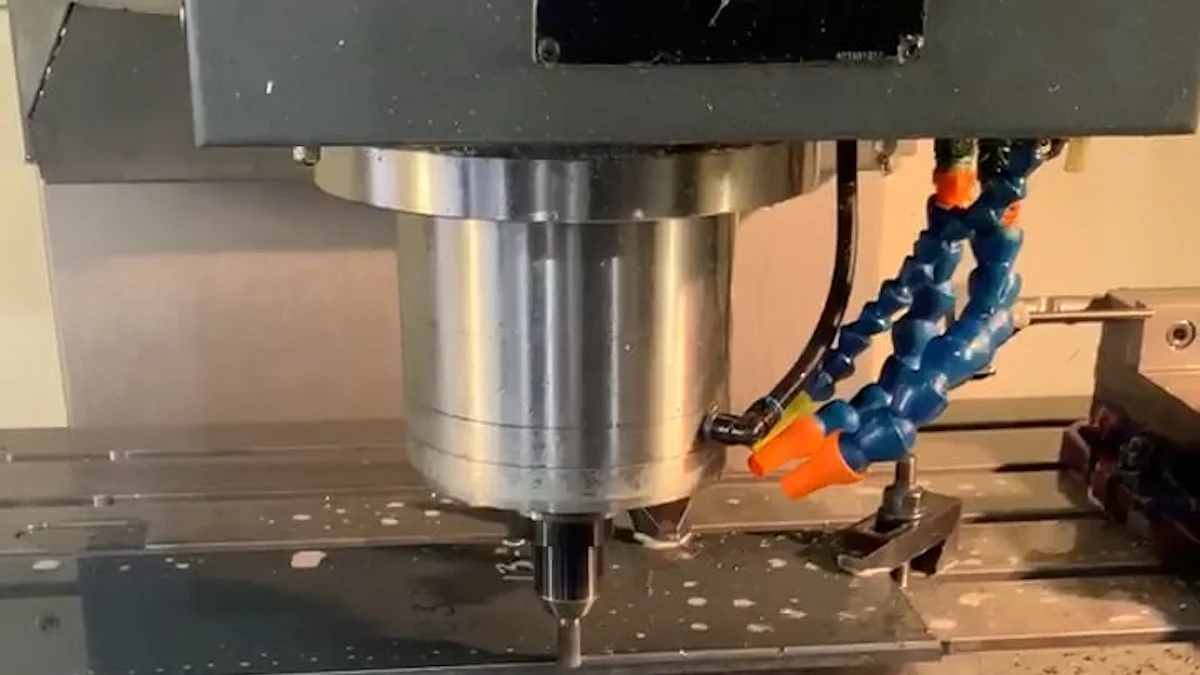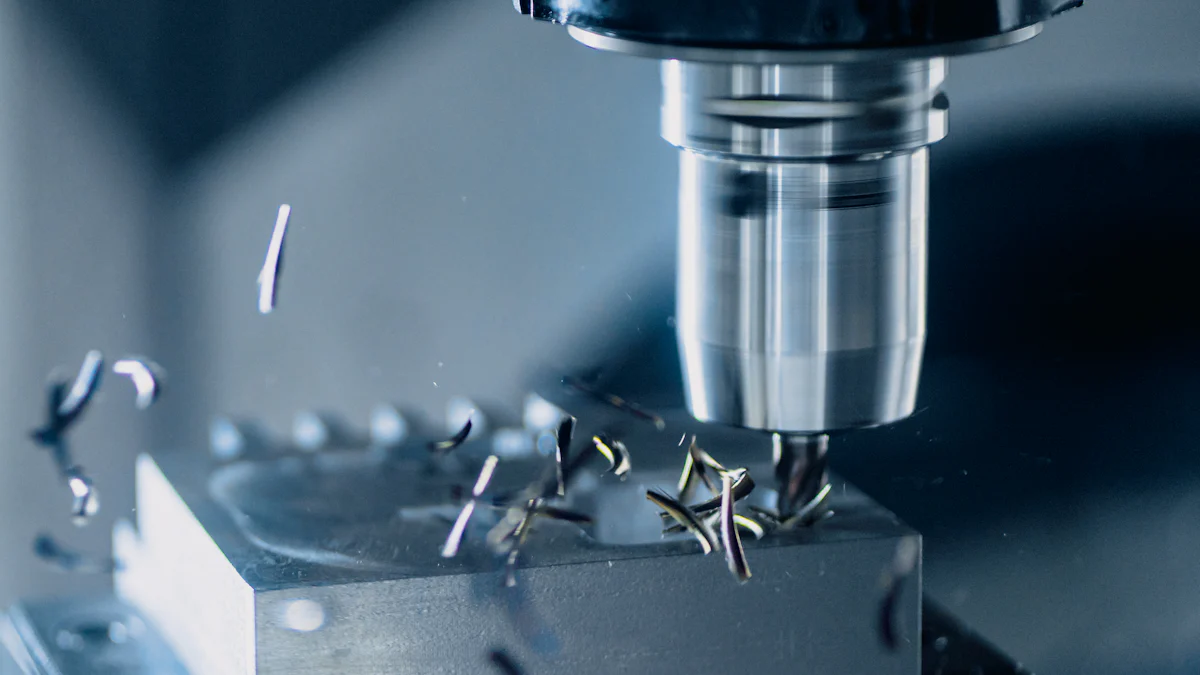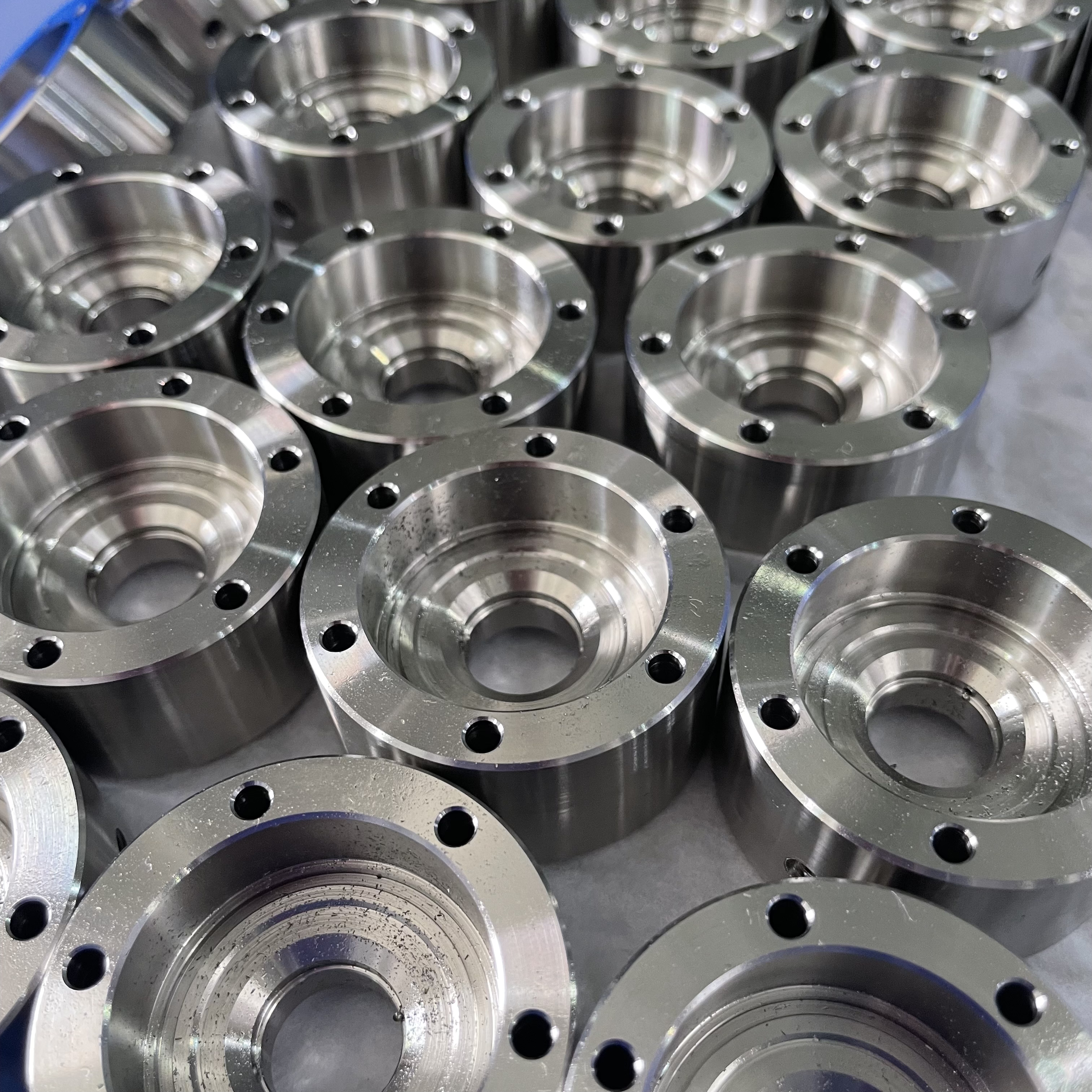Understanding CNC Pricing: How to Get the Best Value for Your Project

CNC machining can feel like a puzzle when you're trying to figure out the costs. But here's the thing—understanding the factors that drive those costs can save you both time and money. For example, the material you choose plays a big role. Did you know that aluminum 6061-T6, often used in industrial automation, costs around €83.50 per unit? Compare that to stainless steel 304, which can go up to €1705.02 for pipe fixing. The type of machining equipment also matters. A three-axis CNC mill might cost you $20–$30 per hour, while a five-axis mill could double that.
Your design choices are just as important. Complex parts can cost over $160 each, while simpler designs might only run $10–$50. By focusing on these details, you can make smarter decisions and get the best value for your project.
Key Takeaways
Pick materials carefully. Use cheaper, easy-to-cut ones like aluminum.
Make your design simple. Less detail means less work and lower costs.
Work with suppliers. Use their knowledge to save money and talk clearly.
Think about how many you need. Ordering more can make each piece cheaper.
Try online CNC cost tools first. Check with suppliers for exact prices.
Key Factors Influencing CNC Machining Costs

Understanding the factors that determine CNC machining costs can help you make smarter decisions for your project. Let’s break down three key areas: material selection, design complexity, and production volume.
Material Selection
Common materials and their cost implications
The material you choose plays a huge role in determining the overall cost of CNC machining. Some materials are more affordable and easier to machine, while others are expensive or require specialized tools. Here’s a quick look at common materials and their price ranges:
Cost Range (per pound) | Common Uses | |
|---|---|---|
Aluminum | $1 - $5 | Automotive, aerospace, electronics |
Steel | $0.50 - $5 | Various industries, depending on grade and finish |
Stainless Steel | $2 - $15 | Medical, food processing, architectural |
Brass | $4 - $8 | Musical instruments, plumbing fixtures |
Plastics | $1 - $10 | Electronics, automotive, consumer goods |
Balancing your budget with the material’s properties is key. For example, aluminum is lightweight, affordable, and easy to machine, making it a popular choice. On the other hand, stainless steel offers durability but comes with higher costs due to its toughness and machining difficulty.
How material properties affect machining time and cost
The machinability of a material directly impacts CNC machining costs. Softer materials like plastics or aluminum are quicker to machine, reducing labor and machine time. Tougher materials like titanium or stainless steel require more effort, leading to increased tool wear and longer machining times. If your project involves high-performance materials, expect higher costs due to these challenges.
Design Complexity
Impact of intricate designs on machining time
Your design choices can make or break your budget. Complex parts with intricate geometries take longer to machine. Features like deep pockets or undercuts often require specialized tools or multiple setups, which increase machining time and costs. For example, a part with deep internal pockets might need a slender end mill, which slows down the process and raises the cost.
How tolerances and precision requirements influence costs
Tight tolerances and high precision add another layer of complexity. Achieving these requires advanced machinery and skilled operators, which drive up costs. If your design doesn’t need extreme precision, consider relaxing the tolerances to save money. Simpler designs not only reduce machining time but also make the process more efficient.
Production Volume
Cost differences between prototypes and bulk production
The number of parts you need significantly affects the cost per unit. Prototypes or small production runs often have higher costs per unit because setup expenses dominate. For example, producing a single part might cost $40, but the price drops to $12.50 per unit for a batch of 10.
Economies of scale in CNC machining
Larger production volumes benefit from economies of scale. As you increase the quantity, fixed costs like setup and tooling get spread across more units, reducing the cost per part. For instance, producing 100 parts can bring the cost down to $8.79 per unit, a reduction of over 60% compared to a single unit. This makes bulk production a cost-effective option for CNC machining products.
Finishing and Post-Processing
Types of finishes and their cost impact
Finishing adds the final touch to your CNC machining project, but it can also increase costs. Different finishes serve different purposes, from improving aesthetics to enhancing durability. For example, anodizing creates a protective oxide layer on aluminum, while powder coating provides a smooth, colorful finish. These processes require extra labor, materials, and equipment, which can raise the overall cost.
Some finishes, like bead blasting, are more budget-friendly. They create a uniform matte texture without breaking the bank. On the other hand, high-quality finishes often involve additional machining steps or specialized techniques, which can drive up expenses. If your project doesn’t demand a flawless surface, you might save money by opting for as-machined parts.
💡 Tip: Evaluate your project requirements carefully. Relaxing tolerances or choosing simpler finishes can reduce machining time and save you money.
Additional processes like polishing, painting, or coating
Post-processing doesn’t stop at finishes. Tasks like deburring, polishing, and assembly are essential for ensuring your parts meet quality standards. These steps, while necessary, can significantly increase costs. Polishing, for instance, smooths out rough edges but requires skilled labor and extra time. Painting or coating adds another layer of protection or color but involves additional materials and equipment.
Quality assurance inspections, material removal, and testing are also part of post-processing. These steps ensure your CNC machining products meet specifications, but they add to the total cost. If you’re looking to cut expenses, consider skipping non-essential processes or discussing cost-effective alternatives with your supplier.
🛠️ Note: While post-processing enhances the functionality and appearance of your parts, it’s important to balance these benefits with your budget.
How to Calculate CNC Machining Cost
Breaking down CNC machining costs can feel overwhelming, but understanding the main components makes it manageable. Let’s dive into the key factors that influence your project’s budget and how you can estimate costs effectively.
Breaking Down the Cost Components
Material costs
The material you choose directly impacts your CNC project’s cost. Raw materials like aluminum or steel are priced based on type, quality, and availability. For example, aluminum is lightweight and affordable, while stainless steel offers durability but costs more due to its machining difficulty. To calculate material costs, multiply the weight of the material by its price per pound. Don’t forget to account for waste or scrap, especially if your design involves intricate cuts.
Machine time and labor costs
Machine runtime is a major contributor to CNC machining costs. Longer machining times mean higher costs, as machines consume energy and tools wear out. Labor costs also play a role, even with automation. Skilled operators are needed to set up machines, monitor production, and ensure quality. For example, a three-axis CNC mill might cost $20–$30 per hour, while a five-axis mill could cost double that due to its advanced capabilities.
Setup and tooling expenses
Every CNC project requires setup, which includes programming the machine and securing the material. Custom fixtures or specialized tools may be needed for unique designs, adding to the cost. For instance, a custom tool could cost anywhere from $50 to $500. Optimizing toolpaths during setup can help reduce the cost by saving machining time.
Using Online CNC Cost Calculators
Benefits of cost estimation tools
Online CNC cost calculators are a quick and efficient way to estimate project expenses. They provide accurate quotes, helping you budget better. These tools also assist in strategic planning, especially if you’re bidding on contracts.
Advantage | Description |
|---|---|
Efficiency | Quickly generate cost estimates for your CNC machining project. |
Accuracy | Predict machining costs with precision, reducing surprises. |
Strategic Planning | Plan and track costs effectively for better decision-making. |
Limitations and accuracy considerations
While these tools are helpful, they’re not perfect. They rely on the data you input, so inaccurate details can lead to misleading estimates. Factors like material availability, machine wear, or unexpected design changes might not be accounted for. Use these calculators as a starting point, but always confirm with a supplier for a more detailed quote.
Requesting Quotes from Suppliers
What to include in your project specifications
When requesting quotes, provide detailed specifications to avoid miscommunication. Include information like:
Material type and quantity.
Surface finishes and post-processing requirements.
Tooling needs and assembly operations.
Quality assurance measures, such as 100% inspection of critical features.
The more precise your details, the more accurate your quote will be.
Comparing quotes for the best value
Don’t just focus on prices when comparing quotes. Look at the supplier’s experience, equipment quality, and lead times. Ensure the quote is transparent, covering all potential costs like setup, tooling, and finishing. A supplier offering the lowest price might cut corners, so balance cost with quality and reliability.
💡 Tip: Build relationships with trusted suppliers. Long-term partnerships often lead to better pricing and smoother communication.
Practical Tips to Reduce the Cost of CNC Machining

Reducing CNC machining costs doesn’t have to be complicated. By making smart choices about materials, design, and production processes, you can save money without sacrificing quality. Let’s explore some effective tips to minimize CNC machining cost.
Choose the Right Material
Balancing cost, durability, and machinability
Selecting the right material is one of the easiest ways to reduce the cost of your CNC project. Materials like aluminum are highly machinable, affordable, and durable, making them a popular choice for industries like aerospace and healthcare. Stainless steel, especially 303-grade, offers a great balance of cost and performance with excellent strength and corrosion resistance. Brass is another option, known for its machinability and versatility.
When choosing a material, think about your project’s requirements. Does it need to withstand high temperatures or resist corrosion? Balancing these factors with machinability ensures you get the best value for your money.
Substituting expensive materials with cost-effective alternatives
If your design allows, consider swapping out costly materials for more affordable ones. Softer metals like aluminum 6061 are easier to machine, cutting down on machining time and tool wear. Harder materials, while durable, often require specialized tools and longer machining times, which drive up costs. By choosing a material that’s easier to work with, you can save on both raw material costs and production time.
Simplify Your Design
Reducing unnecessary complexity
Complex designs can quickly inflate costs. Features like deep pockets, tight tolerances, or intricate geometries require more machine time and specialized tools. Simplifying your design can make a big difference. For example, rounded internal corners reduce tool passes, while avoiding deep pockets minimizes machining challenges. Evaluate your model and remove any features that don’t add value to the final product.
Designing for manufacturability (DFM) principles
Efficient design practices, like following DFM principles, can significantly improve cost efficiency. Standardizing hole sizes and thread types reduces the need for special tools. Simplifying part geometry lowers machining complexity and setup time. By considering manufacturability during the design phase, you can avoid costly mistakes and ensure a smoother production process. Remember, design decisions account for 70% of a CNC part’s manufacturing costs, so optimizing early pays off.
Optimize Production Efficiency
Grouping similar parts for batch production
Producing parts in batches is a great way to save time and money. Grouping similar parts reduces setup times and allows machines to run more efficiently. For example, if you’re manufacturing multiple identical units, batching minimizes the intervals between setups, improving turnaround time. This approach also leverages group technology, which optimizes machine usage and enhances overall production efficiency.
Minimizing setup changes to save time
Frequent setup changes can slow down production and increase costs. To streamline your CNC machining project, try to minimize these changes. Grouping parts with similar features or materials can help reduce the need for retooling. This not only saves time but also ensures a faster turnaround for your CNC machining products.
💡 Tip: Collaborate with your supplier to identify opportunities for batching or reducing setups. Their expertise can help you achieve better cost efficiency.
Collaborate with Your Supplier
Leveraging supplier expertise for cost-saving suggestions
Your supplier isn’t just a vendor—they’re a valuable partner in reducing costs and improving efficiency. By tapping into their expertise, you can uncover practical ways to save money on your CNC machining project. Suppliers often have years of experience working with different materials, designs, and machining techniques. Why not take advantage of that?
Here are some cost-saving suggestions they might offer:
Optimize your design to minimize waste and machining time.
Choose materials that balance performance and affordability.
Relax tolerances or simplify surface finishes where possible.
Consolidate orders to benefit from volume discounts.
Consult with their engineers to refine your model for manufacturability.
For example, if your design includes complex geometries, your supplier might suggest simpler alternatives that reduce machining time. Or, they could recommend a material that’s easier to machine but still meets your quality standards. Open communication with your supplier can lead to creative solutions that lower costs without compromising the functionality of your CNC machining products.
💡 Tip: Don’t hesitate to ask your supplier for advice. Their insights can help you make smarter decisions and avoid unnecessary expenses.
Building long-term relationships for better pricing
Building a strong relationship with your supplier can pay off in the long run. When you establish trust and transparency, suppliers are more likely to offer competitive pricing and prioritize your projects. Long-term partnerships create a win-win situation—you get better deals, and they secure consistent business.
Here’s how you can foster a lasting partnership:
Strategy | Description |
|---|---|
Establish Clear Communication | Ensure both parties understand the terms and expectations to avoid misunderstandings. |
Develop Trust | Show reliability by paying on time and maintaining consistent orders. |
Be Transparent | Share your project goals and challenges to encourage honest feedback and collaboration. |
Consider Long-Term Partnerships | Express your interest in a long-term relationship to motivate suppliers to offer better pricing. |
For instance, regularly reviewing contracts or exploring bulk purchase discounts can lead to significant savings. Suppliers may also prioritize your orders during busy periods if they value your partnership. By maintaining open communication and showing loyalty, you can unlock better pricing and even gain access to exclusive cost-saving opportunities.
🛠️ Note: A strong supplier relationship isn’t just about pricing. It also ensures consistent quality and smoother project execution.
Common Mistakes to Avoid in Your CNC Project
Overlooking Material Costs
Choosing materials without considering machinability
When selecting a material for your CNC machining project, machinability often gets overlooked. This can lead to higher costs and longer production times. Harder materials like stainless steel or titanium may seem appealing for their durability, but they require more effort to machine. This increases tool wear and machining time, driving up costs. On the other hand, softer materials like aluminum or plastics are easier to machine and more budget-friendly. Always balance performance with machinability to avoid unnecessary expenses.
Ignoring waste and scrap material costs
Material waste is another hidden cost that many overlook. Intricate designs or tight tolerances often result in more scrap material. If you don’t account for this, your project’s budget can spiral out of control. Additionally, ensure the material is available in the required size and form to minimize waste. For example, using oversized stock can lead to excessive scrap, which adds to your overall costing. Planning ahead can help you reduce waste and save money.
Ignoring Design for Manufacturability
Including unnecessary features that increase machining time
Complex designs might look impressive, but they can inflate machining costs. Features like deep pockets, sharp internal corners, or intricate geometries require specialized tools and longer machining times. These add to the overall cost without necessarily improving the functionality of your parts. Simplify your design wherever possible. Rounded corners, for instance, are easier to machine and reduce tool wear.
Failing to consult with engineers during the design phase
Skipping a consultation with engineers is a common mistake. Engineers can provide valuable insights into how to optimize your design for manufacturability. They might suggest changes that reduce machining time or material waste. For example, standardizing hole sizes or thread types can eliminate the need for custom tools. Collaborating with engineers early on can save you time and money while ensuring your CNC machining products meet quality standards.
Focusing Solely on Upfront Costs
Neglecting long-term durability and performance
Choosing the cheapest material or supplier might save you money initially, but it can cost you more in the long run. Inferior materials may not withstand wear and tear, leading to frequent replacements or repairs. Similarly, low-quality machining can result in parts that fail to perform as expected. Always consider the long-term value of your project. Investing in durable materials and reliable suppliers ensures better performance and fewer headaches down the road.
Choosing the cheapest supplier without assessing quality
Going for the lowest quote might seem like a smart move, but it often comes with risks. Cheap suppliers may use subpar materials or outdated equipment, leading to compromised quality. You might face issues like inconsistent tolerances, production delays, or hidden costs from frequent repairs. Always evaluate a supplier’s reputation, equipment, and support services before making a decision. A slightly higher upfront cost can save you from costly rework or missed deadlines later.
💡 Tip: Think of your CNC machining project as an investment. Balancing cost, quality, and performance will help you achieve the best results.
Poor Communication with Suppliers
Providing incomplete or unclear project specifications
When you don’t provide clear project details, you leave room for errors and misunderstandings. Suppliers can’t read your mind. If your specifications are vague, they might make assumptions that don’t align with your expectations. This can lead to delays, higher costs, or even parts that don’t meet your quality standards.
For example, imagine you need CNC machining for a custom bracket. If you don’t specify the material, surface finish, or tolerances, the supplier might choose options that don’t suit your design. You could end up with a product that’s either over-engineered or not functional.
To avoid this, always include detailed information in your project brief. Mention the material, dimensions, tolerances, and any post-processing requirements. If your design has unique features, highlight them. The more precise you are, the better your supplier can meet your needs.
💡 Tip: Use drawings or CAD files to communicate your design clearly. Visual aids reduce the chances of misinterpretation.
Failing to ask for cost-saving recommendations
Suppliers are experts in machining. If you don’t ask for their advice, you’re missing out on valuable insights that could save you money. They’ve worked on countless CNC machining products and know how to optimize designs for efficiency.
For instance, your supplier might suggest a different material that’s easier to machine but still meets your requirements. Or they could recommend slight changes to your design that reduce machining time without compromising functionality. These small adjustments can significantly lower your costing.
Don’t hesitate to ask questions like, “Is there a more cost-effective way to produce these parts?” or “Can we simplify the design to save time?” Suppliers appreciate collaboration and are often happy to share their expertise.
🛠️ Note: Building a good relationship with your supplier encourages open communication. This leads to better solutions and smoother project execution.
Getting the best value for your CNC project starts with understanding the factors that influence costs. Choose materials that balance machinability, durability, and affordability. Simplify your design to reduce machining time and avoid unnecessary complexity. Collaborate with suppliers to explore cost-saving opportunities and maintain open communication for better pricing. Efficient machining practices, like optimizing tools and machine parameters, can also enhance productivity. By focusing on quality, clear communication, and long-term planning, you’ll create CNC machining products that meet your needs without overspending.
FAQ
What is the average cost of CNC machining per hour?
The cost depends on the machine type. A three-axis CNC mill typically costs $20–$30 per hour, while a five-axis mill can go up to $60 or more. Labor and material costs also affect the final price.
How can I reduce CNC machining costs for prototypes?
Simplify your design and use cost-effective materials like aluminum. Group similar parts for batch production to save setup time. Collaborate with your supplier for design optimization and cost-saving suggestions.
Do tighter tolerances always increase costs?
Yes, tighter tolerances require advanced machinery and skilled operators, which increase costs. If your project doesn’t need extreme precision, relax the tolerances to save money without compromising functionality.
Are online CNC cost calculators accurate?
They’re a good starting point for estimates. However, they rely on the data you provide and may not account for material availability or design changes. Always confirm with a supplier for a detailed and accurate quote.
What should I include when requesting a CNC machining quote?
Provide detailed specifications like material type, dimensions, tolerances, surface finishes, and post-processing needs. Include CAD files or drawings to ensure clear communication and accurate pricing from suppliers.
💡 Tip: The more details you provide, the fewer surprises you’ll face in the final cost.
See Also
Understanding Key Elements That Influence CNC Part Costs
Unraveling CNC Milling Costs: What You Need to Know
Key Drivers Behind CNC Precision Parts Manufacturing Expenses
About US
Follow Us
Your prototype holds unparalleled significance, and we deeply value its uniqueness. Collaborating with you during the preparation phase for running your prototype or parts is a commitment we gladly embrace. Whether it's a single part or a complex assembly, we are dedicated to selecting the optimal tools and pathways to bring your envisioned product to life.
At Precision Fab CNC Machining, we specialize in producing parts for prototypes, short runs, and high-volume production. Our prototyping machine capabilities extend across metal, plastic, and wood machining, with welding fabrication services available to complement and finalize your prototype if required.
Address
Address: Room320 10F, Building A,Nanshan international building, Dayawan District, Huizhou, Guangdong, 516001 China
Contacts
billy@timaycnc.com

